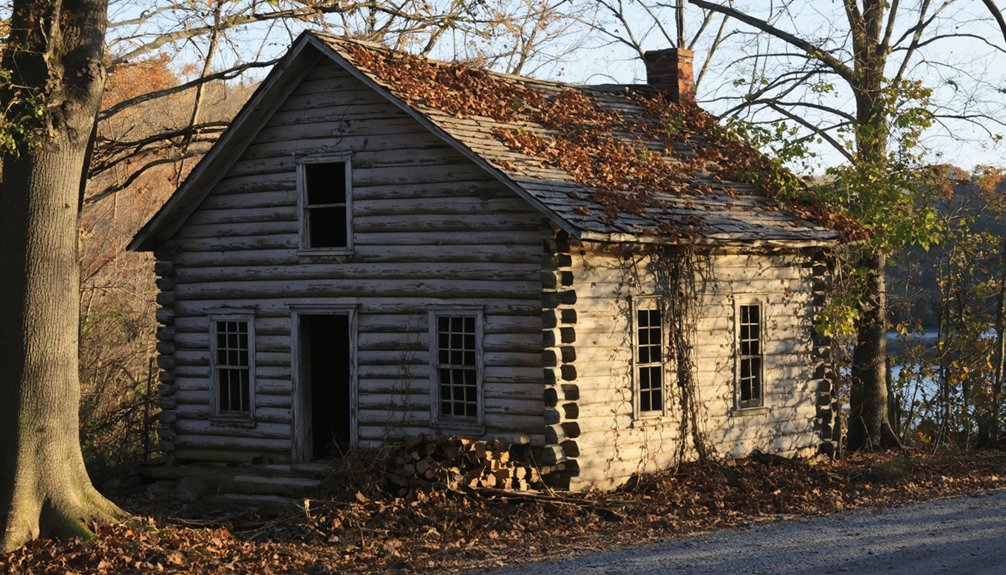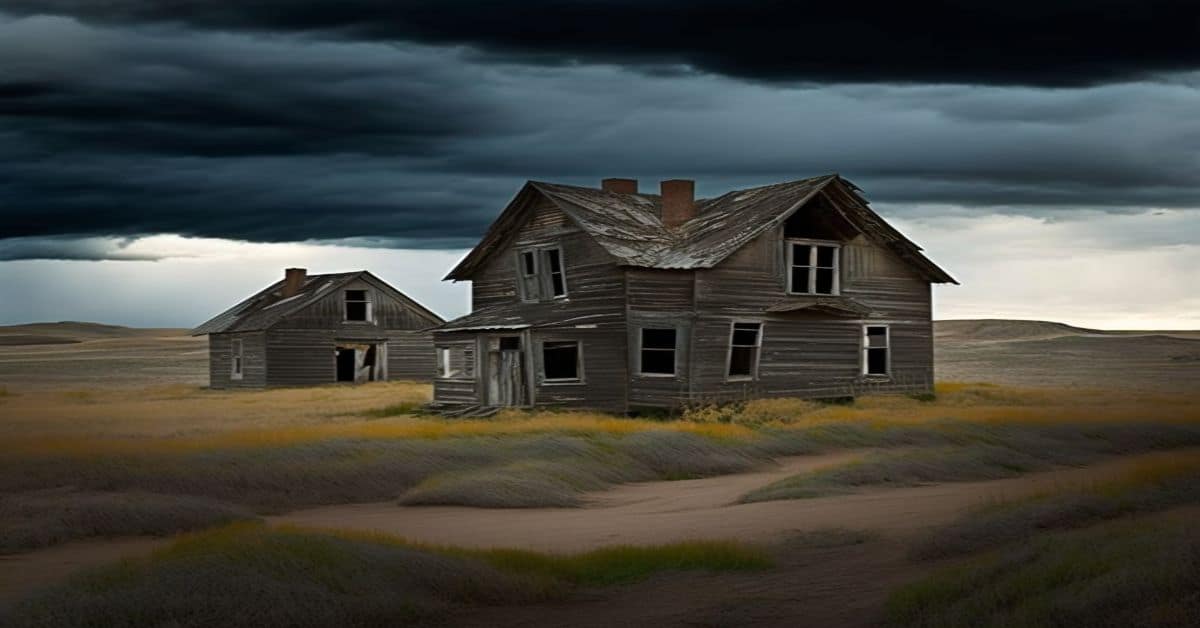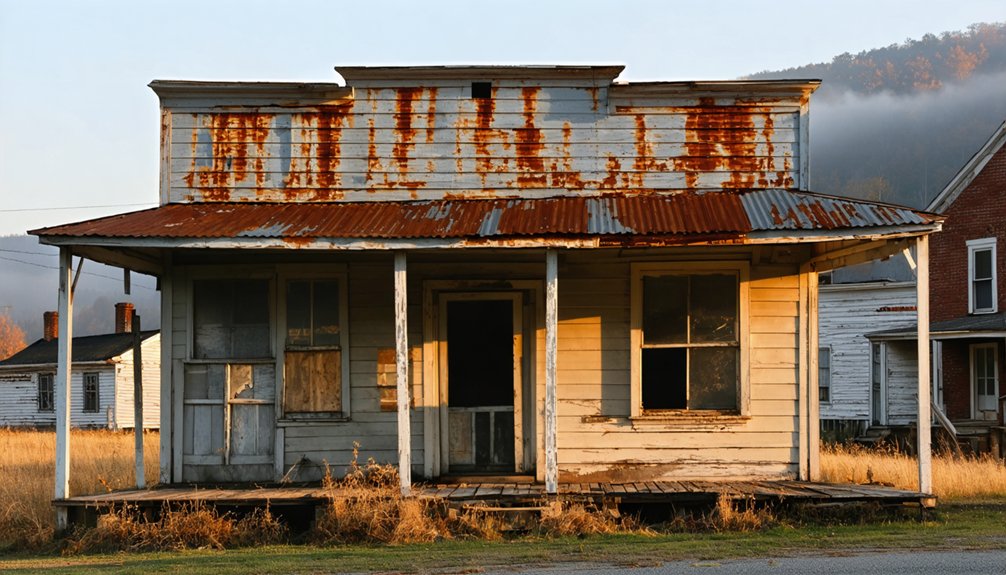You’ll discover Creelsboro, Kentucky, as a former bustling Cumberland River port town that flourished in the 1800s. Located between Nashville and Burnside, this strategic settlement saw thousands of visitors, merchants, and steamboats during its peak. The town’s decline began in the 1930s when modern highways redirected commercial traffic away from the river. Today, only Campbell’s Country Store and scattered ruins remain, though the historic Rockhouse Natural Arch still beckons adventurous explorers.
Key Takeaways
- Creelsboro was once a bustling Cumberland River port town established in 1806, but declined after highways replaced river transportation in the 1930s.
- Today, only ruins and Campbell’s Country Store remain from Creelsboro’s prosperous era as a major commercial river port.
- The town’s abandonment occurred when businesses closed and residents left after steamboat services became obsolete.
- Though now considered a ghost town, Creelsboro’s heritage lives on through historic structures, family cemeteries, and preserved landmarks.
- Agriculture became the primary survival means for remaining residents after the town’s commercial decline.
The Rise of a River Port Town
When Creelsboro gained its official river port designation in 1806, it marked the beginning of the town’s rise as a vital commercial hub along the Cumberland River. You’ll find it was one of only a few river crossings for hundreds of miles between Nashville, Tennessee, and Burnside, Kentucky, making it essential for river transportation and trade. Named after pioneer Elijah Creel, the town’s location proved ideal for development.
Despite its small permanent population of about 50 residents, you’d have seen thousands of visitors passing through annually. The town’s strategic location near fertile bottomlands supported local agriculture, while its position as a commercial hub attracted diverse businesses.
Incorporated in 1836, Creelsboro grew steadily as a thriving river town. You could’ve found a bank, school, three stores, and an inn serving steamboat passengers. By the mid-19th century, Creelsboro had become the busiest river port in its stretch of the Cumberland.
Life Along the Cumberland River
You’d have found a thriving culture of self-sufficiency developing, with settlers like James Robertson and Kaspar Mansker leading the way.
Pioneers like Robertson and Mansker forged a resilient frontier culture, where self-reliance became the cornerstone of survival.
The river served as an essential transportation route, connecting to the Ohio and Mississippi rivers, though early travelers faced risks from uncharted waters and conflicts with Native Americans. Prior to European settlement, the Shawnee people called this waterway Wasioto.
Local economies emerged around natural resources, with timber, coal, and subsistence farming supporting the growing communities.
This cultural heritage, shaped by both indigenous peoples and settlers, continues to influence the region today.
Early settlers primarily cultivated corn and wheat as they established their farms in the fertile valley.
The Historic Rockhouse Natural Arch
You’ll find one of America’s most impressive geological landmarks at Creelsboro’s Rockhouse Natural Arch, a 300,000-year-old meander bridge that stands as the largest stone arch east of the Rocky Mountains.
The arch’s summit holds sacred significance as a Native American burial ground, connecting modern visitors to the region’s indigenous heritage. Early settlers and Native Americans used this impressive formation as a natural shelter for protection against harsh weather conditions.
Today, you can explore this natural wonder along maintained trails while appreciating its role as both a historical community gathering place and a preserved monument to Kentucky’s geological past. The massive structure spans 140 feet wide and reaches a height of 40 feet, making it an awe-inspiring sight for visitors.
Ancient Geological Wonder
Standing majestically along the Cumberland River in Russell County, Kentucky, the Creelsboro Natural Arch represents one of the most impressive geological formations east of the Rocky Mountains.
You’ll find this massive limestone arch spanning up to 140 feet wide and reaching heights of 60 feet, carved by natural erosion over 300 to 400 million years. The geological preservation of this landmark showcases nature’s persistent force, as ancient streams cut through dense rock sediment and topsoil to create this enduring structure. The site served as a crucial shelter for Native American burials and settlements. The structure provides visitors with a unique tunnel-like experience rather than a typical arch walkthrough.
Before Wolf Creek Dam’s construction, periodic flooding submerged portions of the arch, contributing to its unique formation.
Today, you can access this natural wonder through private property owned by the preservation-minded Goff family, who’ve protected it from development and earned it National Natural Landmark status in 1987.
Native American Heritage
Long before European settlers arrived in Kentucky, the majestic Rockhouse Natural Arch served as an essential shelter and sacred burial ground for Native American communities along the Cumberland River.
You’ll find that this natural landmark played an important role in Native American traditions, as it was part of an extensive network of settlements that facilitated trade and communication throughout the region.
The Cumberland River’s strategic importance allowed indigenous peoples to transport goods and maintain connections between communities, making the Rockhouse area a critical hub of activity.
The cultural significance of this site continues to resonate today, as archaeologists and historians work to preserve and document the rich heritage of the Native American peoples who first called this remarkable place home.
Kentucky Educational Television brought this rich history to life through their documentary “Creelsboro and the Cumberland: A Living History.”
Modern Recreation Destination
Today, the majestic Rockhouse Natural Arch stands as one of Kentucky’s premier outdoor destinations, drawing nature enthusiasts and adventure seekers to its impressive 120-foot span.
You’ll discover this hidden gem near Jamestown, where outdoor activities range from hiking to scenic photography amid dense forests and rugged terrain.
When you visit this natural wonder, you’ll experience:
- A challenging but rewarding trek along gravel roads and creek beds to reach the arch
- An uncrowded, serene environment perfect for capturing stunning photos of the 60-foot-high formation
- A chance to explore one of the largest natural stone arches east of the Rockies
- An authentic wilderness adventure with limited facilities, offering true freedom from modern distractions
The arch’s secluded location and pristine surroundings make it an ideal escape for those seeking solitude in nature. The unique geological formation consists of Upper Ordovician dolomite, setting it apart from typical sandstone arches in the region.
Commerce and Daily Life in the 1800s
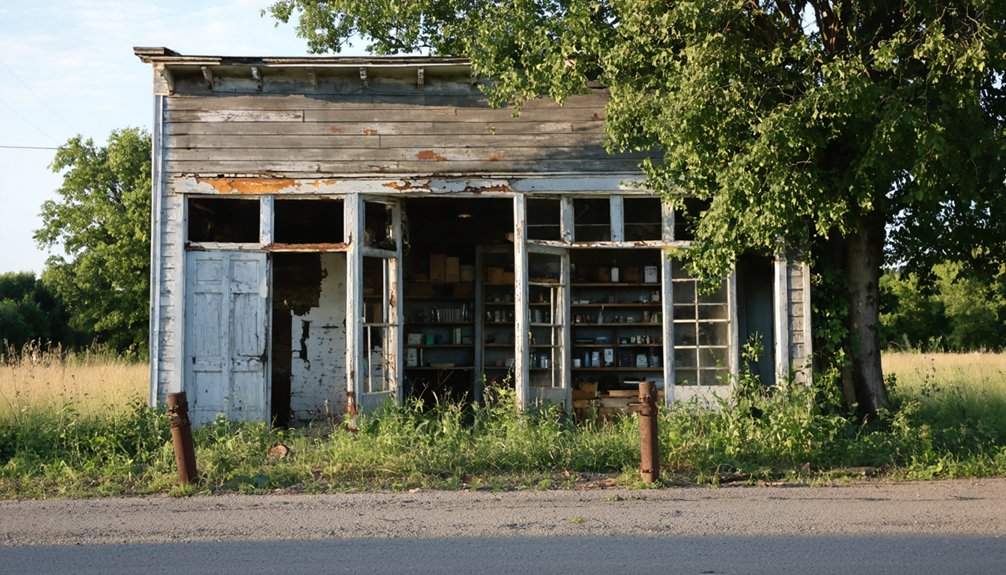
During the 1800s, Creelsboro flourished as an essential commercial hub along the Cumberland River, serving as the busiest port between Nashville and Burnside.
You’d find a bustling town of about 50 residents, supported by three stores, an inn, and a bank that served both locals and travelers. The rich bottomlands enabled prosperous farming practices, with families producing grain, tobacco, and livestock for both sustenance and trade.
Life centered around the steamboat landing, where you’d witness a constant flow of goods and people.
Community gatherings often took place at landmarks like Rockhouse Natural Bridge, while the town’s school served local children.
The surrounding rural families relied on Creelsboro’s merchants for goods they couldn’t produce themselves, creating a thriving network of commerce and social interaction.
From Bustling Port to Abandoned Settlement
You’ll find that Creelsboro’s prosperity peaked in the 1800s when it served as the busiest Cumberland River port between Nashville and Burnside, hosting a vibrant mix of steamboats, merchants, and travelers.
The town’s fortunes changed dramatically in the 1930s when new highways redirected commercial traffic away from the river routes, leading to the rapid exodus of businesses and residents.
Today, only scattered ruins and the historic Campbell’s Country Store stand as evidence to Creelsboro’s once-thriving river trade era, though the area continues to draw visitors interested in its natural landmarks and rich history.
River Trade Era Glory
Despite its modest population of around 50 residents, Creelsboro emerged as one of the upper Cumberland River’s most significant commercial ports in the 19th century.
The riverboat lifestyle transformed this small Kentucky town into a vibrant hub along essential trade routes between Nashville and Burnside.
You’d have witnessed a thriving commercial center where:
- Steamboats regularly docked to exchange agricultural goods from the fertile bottomlands
- Merchants operated three bustling stores, a bank, and an inn for travelers
- Farmers traded their tobacco, grain, and livestock for imported necessities
- The strategic river crossing served as a critical lifeline for military operations during the Civil War
The town’s location on one of the few Cumberland River crossings cemented its importance as a regional powerhouse of commerce and transportation.
Highway Impact Devastates Town
When modern highways emerged across Kentucky in the 1930s, Creelsboro’s destiny changed dramatically as commercial traffic shifted away from its once-bustling river port.
You’d have witnessed a swift highway disruption that rendered the town’s steamboat services increasingly obsolete, forcing local businesses to shutter their doors.
The community decline was devastating. As the new road networks redirected trade routes, Creelsboro lost its position as the region’s primary commercial hub between Nashville and Burnside.
You would’ve seen residents departing as economic opportunities vanished – the bank closed, the inn emptied, and stores went dark.
Those who remained turned to agriculture for survival, marking the end of Creelsboro’s golden age as a vibrant river trade center.
Today, this once-prosperous town stands as a reflection of how transportation infrastructure can reshape communities.
Rural Legacy Lives On
Although Creelsboro’s commercial glory has faded, its rural heritage endures through scattered farmsteads and historic structures that dot the Cumberland River’s edge.
The community heritage remains alive in the hearts of local residents who’ve preserved the town’s memory through generations of storytelling and documentation.
Rural preservation efforts have kept several significant landmarks intact:
- The original one-room schoolhouse where children learned for over seven decades
- A weathered general store that once served as the town’s social hub
- The historic ferry crossing site that connected communities across the Cumberland
- Century-old family cemeteries that chronicle the area’s earliest settlers
You’ll find that while Creelsboro may be considered a ghost town today, its spirit lives on through these tangible connections to Kentucky’s rural past.
Legacy of the Creelsboro Country Store
The Campbell’s Creelsboro Country Store stands as a living monument to Kentucky’s rural heritage since its founding in 1876.
Founded in 1876, Campbell’s Creelsboro Country Store embodies Kentucky’s timeless rural spirit, preserving generations of local history and tradition.
You’ll find this historic landmark at 4838 KY-379, where it’s preserved much of its original rustic architecture and vintage interior, offering an authentic glimpse into 19th-century life.
As one of Kentucky’s last surviving country stores, it continues to serve as a hub for community gatherings while maintaining its historical preservation through careful restoration by a local family.
You can experience the store’s enduring legacy through its vintage goods, local crafts, and traditional treats like hand-churned ice cream.
Operating Thursday through Saturday, the store draws visitors seeking authentic experiences while supporting the local economy and keeping Creelsboro’s rich cultural heritage alive.
Modern Adventures in a Forgotten Town
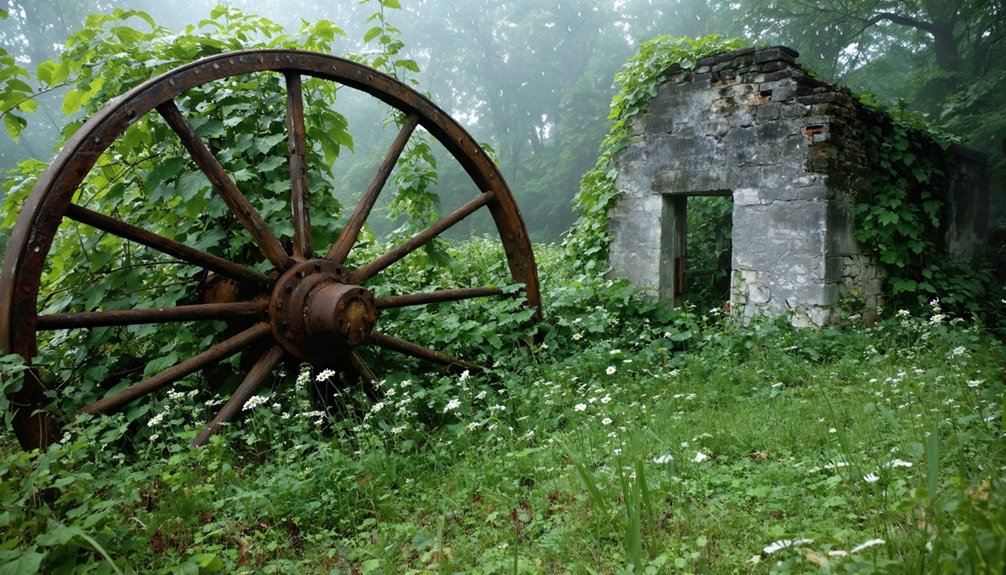
Modern adventurers seeking an authentic ghost town experience will find Creelsboro’s remote location rewards their journey with natural wonders and historical treasures.
The Rockhouse Natural Arch stands as your gateway to both natural exploration and cultural significance, offering a unique blend of geological marvel and human history.
You’ll discover:
- A massive natural arch formed over 300 million years, accessible via a short hike
- Clear waters of the Cumberland River, perfect for trout fishing and paddling
- Historical remnants of Native Americans, long hunters, and moonshiners
- Pristine wilderness devoid of modern development
While amenities are sparse, you’ll find solitude among the rugged Kentucky landscape.
Pack accordingly – there aren’t any modern facilities, but that’s part of the authentic experience you’re seeking in this forgotten corner of Russell County.
Frequently Asked Questions
Are There Any Remaining Descendants of Elijah Creel Living in the Area?
While local genealogy records show extensive Creel family lines, you won’t find any confirmed direct descendants of Elijah Creel living in the area today, despite the family’s significant historical presence.
What Happened to the Original Bank Vault From Creelsboro’s Commercial Era?
Based on available historical records, you won’t find specific information about the bank vault’s fate from Creelsboro’s commercial era, as documentation about banking facilities from that period remains incomplete.
Were Any Civil War Battles or Skirmishes Fought Near Creelsboro?
Like breaking news in 1863, Civil War skirmishes erupted near Creelsboro. You’ll find local history records showing Union Lt. Col. Riley’s surprise attack and several battles for control of the Cumberland River.
Does Anyone Still Operate Farms on the Original Creelsboro Town Site?
You’ll find small-scale family farms still operating there today, continuing traditional farming techniques and agricultural history through cultivation of crops along the fertile Cumberland River lands.
What Native American Artifacts Have Been Discovered at the Rockhouse Site?
You’ll find projectile points, pottery shards, stone tools, and burial artifacts at this Native American site. The archaeological significance includes fire-cracked rocks showing evidence of hearths within the shelter.
References
- https://www.kentuckyliving.com/explore/the-rockhouse
- https://en.wikipedia.org/wiki/Creelsboro
- https://www.youtube.com/watch?v=ua6VZ_nsero
- https://www.freakyfoottours.com/us/kentucky/
- http://www.columbiamagazine.com/index.php?sid=74464
- https://www.weekendadventures.net/blog/the-rockhouse-creelsboro-natural-arch
- https://brookandholler.com/blogs/trail-guides/creelsboro-natural-bridge-the-seventh-largest-arch-in-the-united-states
- https://kentuckyarchaeologicalsurvey.org/creelsboro/educational-materials/introduction/
- http://columbiamagazine.com/index.php?sid=101359
- https://kentuckyarchaeologicalsurvey.org/creelsboro/
